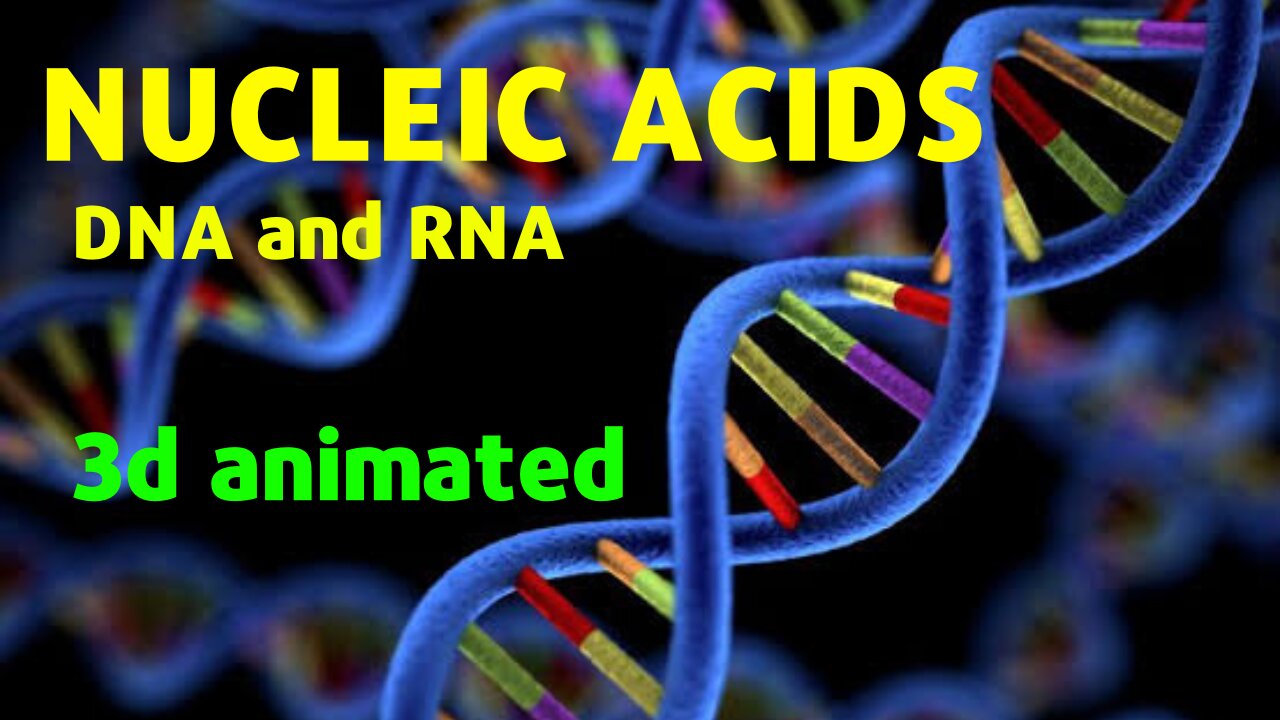Premium Only Content

Nucleic acids 3D animated structure function and its types | DNA | RNA | in urdu/hindi
nucleic acids 3d animated DNA and RNA
Nucleic acids are biopolymers, or small biomolecules, essential to all known forms of life. They are composed of monomers, which are nucleotides made of three components: a 5-carbon sugar, a phosphate group and a nitrogenous base. If the sugar is a simple ribose, the polymer is RNA (ribonucleic acid); if the sugar is derived from ribose as deoxyribose, the polymer is DNA (deoxyribonucleic acid).
#nucleicacids #dna #rna #heredity
#genome
Nucleic acids are the most important of all biomolecules. They are found in abundance in all living things, where they function to create and encode and then store information in the nucleus of every living cell of every life-form organism on Earth. In turn, they function to transmit and express that information inside and outside the cell nucleus—to the interior operations of the cell and ultimately to the next generation of each living organism. The encoded information is contained and conveyed via the nucleic acid sequence, which provides the 'ladder-step' ordering of nucleotides within the molecules of RNA and DNA.
Strings of nucleotides are bonded to form helical backbones—typically, one for RNA, two for DNA—and assembled into chains of base-pairs selected from the five primary, or canonical, nucleobases, which are: adenine, cytosine, guanine, thymine, and uracil; note, thymine occurs only in DNA and uracil only in RNA. Using amino acids and the process known as protein synthesis,[3] the specific sequencing in DNA of these nucleobase-pairs enables storing and transmitting coded instructions as genes. In RNA, base-pair sequencing provides for manufacturing new proteins that determine the frames and parts and most chemical processes of all life forms.
One DNA or RNA molecule differs from another primarily in the sequence of nucleotides. Nucleotide sequences are of great importance in biology since they carry the ultimate instructions that encode all biological molecules, molecular assemblies, subcellular and cellular structures, organs, and organisms, and directly enable cognition, memory, and behavior (See: Genetics). Enormous efforts have gone into the development of experimental methods to determine the nucleotide sequence of biological DNA and RNA molecules,[26][27] and today hundreds of millions of nucleotides are sequenced daily at genome centers and smaller laboratories worldwide
-
 12:03
12:03
Space Ice
9 hours agoSteven Seagal's China Salesman - Mike Tyson Knocks Him Out - Worst Movie Ever
5.68K13 -
 11:37
11:37
Degenerate Jay
8 hours agoJames Bond Needs Quality Over Quantity From Amazon
4.04K2 -
 15:23
15:23
Misha Petrov
8 hours agoTrad Wives & Girl Bosses Go to WAR!
6.59K24 -
 2:03:11
2:03:11
TheDozenPodcast
7 hours agoFootball villain fighting the state: Joey Barton
3.29K -
 LIVE
LIVE
Scottish Viking Gaming
9 hours ago💚Rumble :|: Sunday Funday :|: Smash the Blerps and Vape the Terpes
805 watching -
 1:45:00
1:45:00
RG_GerkClan
11 hours ago🔴LIVE Sunday Special - It's Time for World Domination - Civilization VII - Gerk Clan
58.5K27 -
 LIVE
LIVE
Major League Fishing
4 days agoLIVE Tackle Warehouse Invitationals, Stop 1, Day 3
125 watching -
 23:34
23:34
marcushouse
12 hours ago $15.13 earnedBREAKING: Starship Launch IMMINENT – But What’s This SURPRISE Flight 9 Plan?! 🚀🔥
105K11 -
 8:43
8:43
Film Threat
1 day agoTHE MONKEY | Film Threat Reviews
95.9K3 -
 15:55
15:55
TSPLY
1 day agoThe Media Is Very Afraid Of FBI Director Kash Patel
77.9K59